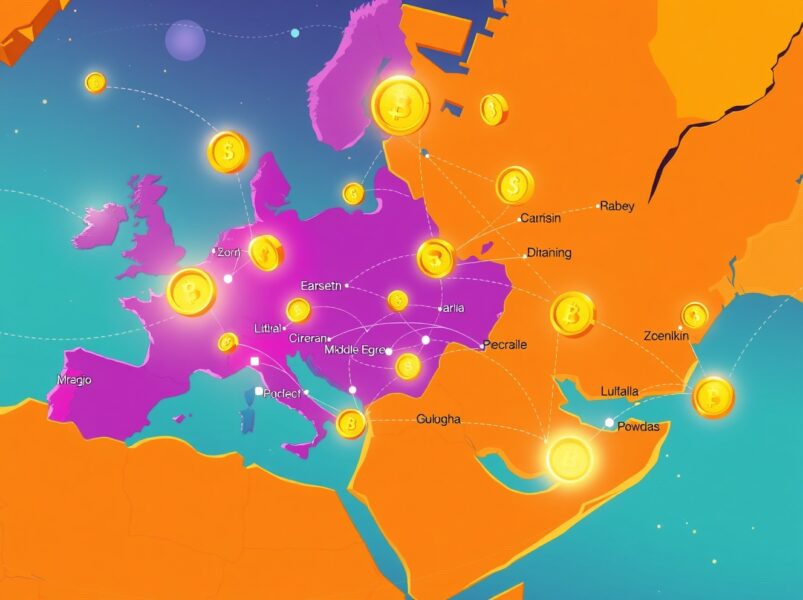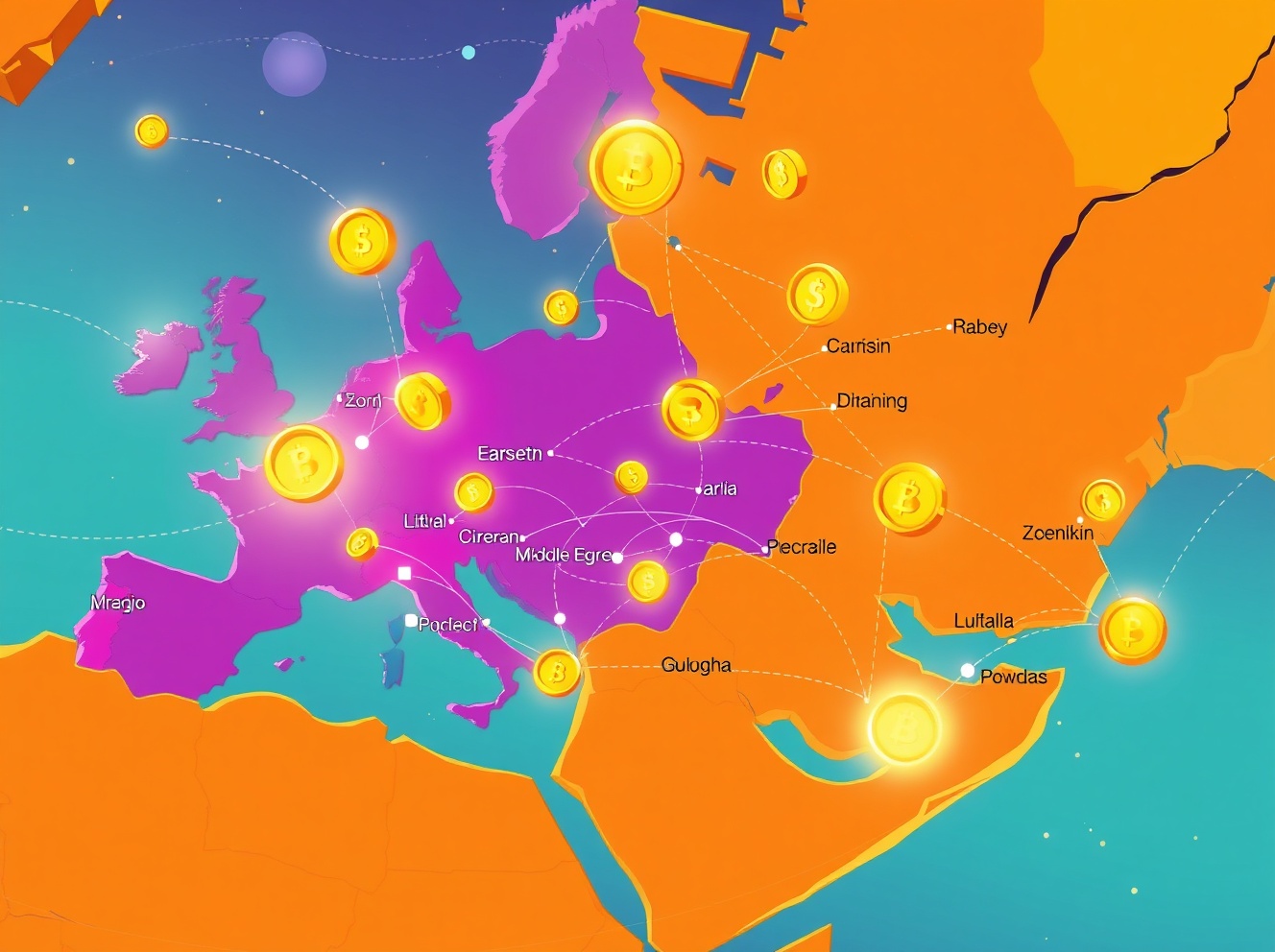Revolutionary Stablecoin Payments Expansion: Visa’s Game-Changing Move Across 3 Continents
Share:

BitcoinWorld

Revolutionary Stablecoin Payments Expansion: Visa’s Game-Changing Move Across 3 Continents
Imagine sending money across borders instantly, 24 hours a day, without traditional banking delays. This vision is becoming reality as Visa announces a massive expansion of its stablecoin payments infrastructure across Eastern Europe, the Middle East, and Africa. This groundbreaking move could transform how millions of people conduct financial transactions in these rapidly developing regions.
What Makes Visa’s Stablecoin Payments Expansion So Significant?
Visa’s partnership with crypto infrastructure firm Aquanow represents a major step toward mainstream cryptocurrency adoption. The collaboration focuses on establishing a 24-hour real-time settlement system using stablecoins. This means businesses and individuals can transfer value across borders without waiting for traditional banking hours or dealing with lengthy processing times.
The timing couldn’t be better. Many countries in these regions face challenges with traditional financial infrastructure. Stablecoin payments offer a practical solution that combines the stability of traditional currencies with the efficiency of blockchain technology.
How Will Stablecoin Payments Benefit These Regions?
The expansion brings several key advantages to Eastern Europe, the Middle East, and Africa. First, it addresses the critical need for faster cross-border transactions. Second, it provides financial inclusion opportunities for unbanked populations. Third, it reduces transaction costs significantly compared to traditional money transfer services.
- 24/7 availability – No more waiting for banking hours
- Lower fees – Dramatically reduced transaction costs
- Faster settlements – Real-time processing instead of days
- Financial inclusion – Access for underserved populations
- Currency stability – Protection against local currency volatility
What Challenges Might This Expansion Face?
Despite the exciting potential, Visa’s stablecoin payments expansion faces several hurdles. Regulatory compliance across multiple jurisdictions remains complex. Different countries have varying approaches to cryptocurrency regulation. Additionally, educating users about stablecoin technology and building trust in these new systems will require significant effort.
Technical infrastructure also presents challenges. Ensuring reliable internet connectivity and digital literacy in some areas will be crucial for successful implementation. However, the partnership with Aquanow brings specialized expertise in crypto infrastructure that should help overcome these obstacles.
Why This Matters for the Future of Global Payments
Visa’s move signals a fundamental shift in how major financial institutions view digital assets. By embracing stablecoin payments, Visa acknowledges the growing importance of blockchain technology in global finance. This expansion could pave the way for other financial giants to follow suit, accelerating the integration of cryptocurrency into everyday financial services.
The real-time settlement capability is particularly transformative. Traditional cross-border payments often take several days to clear. With stablecoin payments, settlements happen almost instantly, providing businesses with better cash flow management and individuals with immediate access to funds.
Conclusion: A New Era for Cross-Border Transactions
Visa’s expansion of stablecoin payments across Eastern Europe, the Middle East, and Africa represents more than just a technological upgrade—it’s a fundamental reimagining of how value moves across borders. This initiative has the potential to democratize financial services, reduce costs, and increase efficiency for millions of people. As this infrastructure develops, we can expect to see accelerated adoption of digital assets in everyday commerce, marking a significant milestone in the evolution of global payments.
Frequently Asked Questions
What are stablecoin payments?
Stablecoin payments involve using cryptocurrency tokens pegged to stable assets like the US dollar to facilitate fast, low-cost transactions on blockchain networks.
Which countries will benefit from Visa’s expansion?
The expansion covers Eastern Europe, the Middle East, and Africa, though specific country rollouts may vary based on local regulations and infrastructure.
How do stablecoin payments differ from traditional bank transfers?
Stablecoin payments offer 24/7 availability, faster settlement times, lower fees, and operate on decentralized networks rather than traditional banking systems.
Is this service available to individual users?
While initially focused on business and institutional clients, the infrastructure could eventually support individual users as the ecosystem matures.
What makes this partnership with Aquanow important?
Aquanow brings specialized cryptocurrency infrastructure expertise, helping Visa navigate the technical complexities of stablecoin integration at scale.
Are stablecoin payments secure?
Yes, blockchain-based stablecoin payments use advanced cryptography and decentralized networks, making them highly secure when properly implemented.
Found this insight into Visa’s stablecoin payments expansion valuable? Share this article with your network to spread awareness about this groundbreaking development in global finance!
To learn more about the latest cryptocurrency trends, explore our article on key developments shaping blockchain technology institutional adoption.
This post Revolutionary Stablecoin Payments Expansion: Visa’s Game-Changing Move Across 3 Continents first appeared on BitcoinWorld.
Revolutionary Stablecoin Payments Expansion: Visa’s Game-Changing Move Across 3 Continents
Share:

BitcoinWorld

Revolutionary Stablecoin Payments Expansion: Visa’s Game-Changing Move Across 3 Continents
Imagine sending money across borders instantly, 24 hours a day, without traditional banking delays. This vision is becoming reality as Visa announces a massive expansion of its stablecoin payments infrastructure across Eastern Europe, the Middle East, and Africa. This groundbreaking move could transform how millions of people conduct financial transactions in these rapidly developing regions.
What Makes Visa’s Stablecoin Payments Expansion So Significant?
Visa’s partnership with crypto infrastructure firm Aquanow represents a major step toward mainstream cryptocurrency adoption. The collaboration focuses on establishing a 24-hour real-time settlement system using stablecoins. This means businesses and individuals can transfer value across borders without waiting for traditional banking hours or dealing with lengthy processing times.
The timing couldn’t be better. Many countries in these regions face challenges with traditional financial infrastructure. Stablecoin payments offer a practical solution that combines the stability of traditional currencies with the efficiency of blockchain technology.
How Will Stablecoin Payments Benefit These Regions?
The expansion brings several key advantages to Eastern Europe, the Middle East, and Africa. First, it addresses the critical need for faster cross-border transactions. Second, it provides financial inclusion opportunities for unbanked populations. Third, it reduces transaction costs significantly compared to traditional money transfer services.
- 24/7 availability – No more waiting for banking hours
- Lower fees – Dramatically reduced transaction costs
- Faster settlements – Real-time processing instead of days
- Financial inclusion – Access for underserved populations
- Currency stability – Protection against local currency volatility
What Challenges Might This Expansion Face?
Despite the exciting potential, Visa’s stablecoin payments expansion faces several hurdles. Regulatory compliance across multiple jurisdictions remains complex. Different countries have varying approaches to cryptocurrency regulation. Additionally, educating users about stablecoin technology and building trust in these new systems will require significant effort.
Technical infrastructure also presents challenges. Ensuring reliable internet connectivity and digital literacy in some areas will be crucial for successful implementation. However, the partnership with Aquanow brings specialized expertise in crypto infrastructure that should help overcome these obstacles.
Why This Matters for the Future of Global Payments
Visa’s move signals a fundamental shift in how major financial institutions view digital assets. By embracing stablecoin payments, Visa acknowledges the growing importance of blockchain technology in global finance. This expansion could pave the way for other financial giants to follow suit, accelerating the integration of cryptocurrency into everyday financial services.
The real-time settlement capability is particularly transformative. Traditional cross-border payments often take several days to clear. With stablecoin payments, settlements happen almost instantly, providing businesses with better cash flow management and individuals with immediate access to funds.
Conclusion: A New Era for Cross-Border Transactions
Visa’s expansion of stablecoin payments across Eastern Europe, the Middle East, and Africa represents more than just a technological upgrade—it’s a fundamental reimagining of how value moves across borders. This initiative has the potential to democratize financial services, reduce costs, and increase efficiency for millions of people. As this infrastructure develops, we can expect to see accelerated adoption of digital assets in everyday commerce, marking a significant milestone in the evolution of global payments.
Frequently Asked Questions
What are stablecoin payments?
Stablecoin payments involve using cryptocurrency tokens pegged to stable assets like the US dollar to facilitate fast, low-cost transactions on blockchain networks.
Which countries will benefit from Visa’s expansion?
The expansion covers Eastern Europe, the Middle East, and Africa, though specific country rollouts may vary based on local regulations and infrastructure.
How do stablecoin payments differ from traditional bank transfers?
Stablecoin payments offer 24/7 availability, faster settlement times, lower fees, and operate on decentralized networks rather than traditional banking systems.
Is this service available to individual users?
While initially focused on business and institutional clients, the infrastructure could eventually support individual users as the ecosystem matures.
What makes this partnership with Aquanow important?
Aquanow brings specialized cryptocurrency infrastructure expertise, helping Visa navigate the technical complexities of stablecoin integration at scale.
Are stablecoin payments secure?
Yes, blockchain-based stablecoin payments use advanced cryptography and decentralized networks, making them highly secure when properly implemented.
Found this insight into Visa’s stablecoin payments expansion valuable? Share this article with your network to spread awareness about this groundbreaking development in global finance!
To learn more about the latest cryptocurrency trends, explore our article on key developments shaping blockchain technology institutional adoption.
This post Revolutionary Stablecoin Payments Expansion: Visa’s Game-Changing Move Across 3 Continents first appeared on BitcoinWorld.



